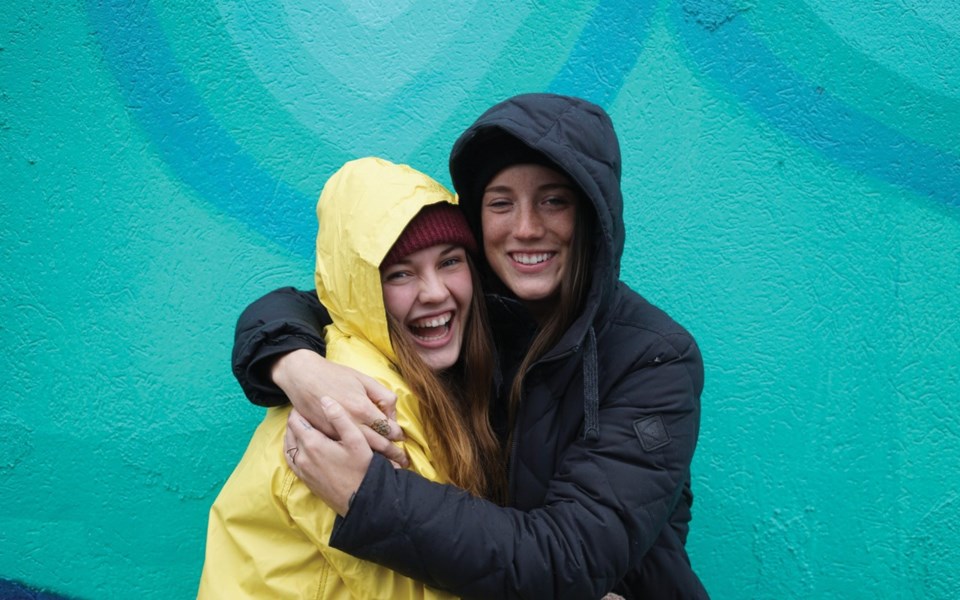After Journey Smith and Andi Wardrop had finished watching the first cut of their debut film, Hope The Documentary, tears streaming down their faces, a question emerged: Is the movie too sad?
"That was our initial thought," said Wardrop, who served as assistant editor and camera operator on the film. "Then, because we were both staring at each other crying, we realized, 'No, this is exactly what we want.' It's so raw and this is the emotion we want to evoke. If we weren't questioning that, I don't think we would have achieved what we wanted to."
What the two family friends had set out to achieve initially started as Smith's Grade 12 project at Whistler Waldorf School. Graduating students are asked to complete a year-long thesis on a subject that matters to them. Smith knew she wanted to explore the role of hope, a feeling that had sometimes been lacking in her young life.
"In my 18 years of life, I have faced a lot of adversity. I was actually diagnosed with a condition called hydrocephalus, which is essentially fluid on the brain. I suffered a stroke at birth," explains Smith, who has undergone numerous brain surgeries over the years and calls the hospital "a second home."
"This project was super important to find other people who have faced different types of adversity and how, through their journey, they'd overcome it."
Her first foray into filmmaking, Smith reached out to Wardrop, a commercial photographer and videographer, at an opportune time.
"(A friend and I) were sitting in the Ottawa airport waiting to go shoot a wedding and we were talking about projects we were working on currently and what the future of our businesses both looked like," she says. "I do a lot of wedding and commercial art that has a quick turnaround time, so I edit and then turn something around in a week. I really wanted to get attached to a project and work on something for a little bit longer. Literally two minutes later, Julie, Journey's mom, and her were on speakerphone and called asking me to do the documentary."
Whether fate or mere coincidence, whatever it was that initially drew the 27-year-old Wardrop to the film, it was Smith's own experiences that really convinced her this was a story worth telling.
"Journey's story, first of all, and probably most of all, is why people get so attached to this film. The few times that (I) had met Journey, it seemed like she didn't have a disability, which is interesting now that I know her so well," explains Wardrop. "Watching her start to give herself permission to be exactly who she is through talking to these other people, as soon as we started the film I knew it was going to be extremely powerful. It was definitely Journey's story that I got attached to."
The process of determining who exactly she would feature in the film was a difficult one, Smith said. She originally considered interviewing complete strangers for the project, before she realized there were already people in her own life that had stories worth sharing.
Smith interviewed her former teacher Chris Dickinson (brother to Whistler Community Services Society director Jackie Dickinson), who is now a support worker on Vancouver's Downtown Eastside. There was local photographer and head of the Whistler Wedding Collective Anastasia Chomlack, a family friend who shared her experience of dealing with breast cancer. Smith reconnected with Jimi Brockett, who launched the mountain-bike charity Riders for Ryder after his son, a friend of Smith's, died from cancer several years ago. The film also features another family friend, Melissa Schneiderova, whose husband collapsed on a hike and later passed way. In what is probably the film's most personal segment, Smith interviews neurosurgeon Dr. Douglas Cochrane, who has been her doctor since she was a toddler.
It's Smith's history with her subjects that lends the film its most poignant moments, the personal connection allowing each interviewee to open up in a way they might not have otherwise.
"I think the most important thing was just giving them permission to be vulnerable with us and letting them know that it was OK to feel the way they did and give it to us as raw as they could," Smith says.
In spite of the film's intimacy, Smith is hopeful its underlying message resonates with a wider audience as well.
"At the beginning of the process, I wouldn't say I was someone who is hopeful all the time," says Smith. "I'm learning, too. There are days when I feel super hopeless and that there's no point in having hope. The biggest thing for me, (and) I would say to that past self or to anyone dealing with adversity, that you don't always have to have hope. It may not always be there, but there are ways you can find it through your community and your environment."
Screenings of Hope The Documentary have already taken place in Whistler and Vancouver, with potential plans to offer more screenings in the future. Smith says she is also exploring releasing the film online after submitting it to festivals. To stay up to date, visit hopethedocumentary.ca.




